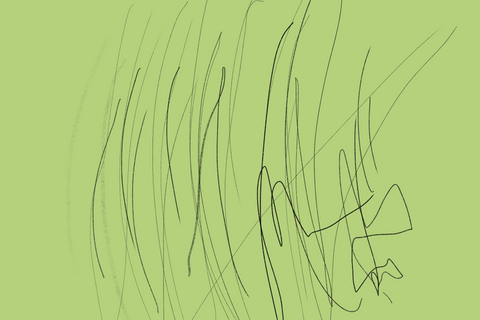We know there is something magic about illustration + art that often seems daunting when we turn our own hands to the blank page, but we're firm believers that anyone can learn to draw. Here we share some of our favourite exercises to conquer the dreaded "I can't draw" and start making, beginning with the skill of mark-making.
Mark-making warms up your hands & brain and refines your fine motor skills so you can create the effects you imagine. It’s also an important practice to continue finding new textures, effects, and expressions – all artists experiment with mark-making!
Let’s first take a look at some interesting marks in artwork featured in Volume Four of Flight.
Mizuki Goto

More about Mizuki: zukkeenee.com | @zukkeeneegocchi | Volume Four: Interview + Art
Mizuki uses acrylic gouache, varnish, collage and packing tape to create her artwork. You can see in each part of the artwork how there are different textures and effects to be found - spots of blue, collaged pieces of paper, broad strokes, small strokes, fine lines, and wonky lines too.
Ryōji Arai

More about Ryōji: Enchanted Lion Books | Detail of image above courtesy of and copyright of Almost Nothing, Yet Everything, published by Enchanted Lion Books, featured in Flight Volume Four
Ryōji paints with acrylic, watercolour, and pencils. You can see lots of different kinds of marks and textures that come together to create the full artwork - scratchy brush strokes, smooth ones, soft pencil lines, blended watercolours, and bold paint.
Now to take your own pencil to the page!
Exercise 1: Pencils
Find a nice large sheet of paper, a good & sharp pencil (these are our absolute favourites), and a timer. For 5 minutes, make as many kinds of marks as you can – soft, hard, quick, slow, big, small, detailed, simple, etc. The aim is to see all the different kinds of marks you can make, and decide which ones are visually interesting to you.

Exercise 2: Drawing things you can’t see
Trying to translate intangible things into marks can make interesting expressions. For example, try and translate a song into marks – how does loudness look like? What about guitar? Voices? Or, perhaps you’d like to translate the rhythm of a swing – how does the to and fro of the swing translate to paper?

The to and fro of a swing captured by holding a pencil and swinging over the page!
Some more ideas: how does a river sound? How does a tree move? What does dancing feel like? What does a dog feel like to pat?
The aim of this exercise is to train your imagination and your hands to convey feelings and ideas through mark-making. Just like Ryoji’s river seems to rush past, and the trees seem to swish, or Mizuki’s horses gallop and play, translating feelings into marks makes your illustrations come alive.
Exercise 3: Paint – gouache, acrylic, watercolour
You can also use mark-making in other mediums. Try mixing mediums too – gouache and pencil, or watercolour and fineliners. Take up lots of space and play with wet, dry, quick, slow, layers, fine, bold, etc.

It’s often helpful to annotate your marks, so you know how you achieved the effect – e.g. ‘mixed cadium yellow + ultramarine blue + dropped water on top’, or ‘dry brushed dark green’. You can create a library of effects that you can refer to when you’re creating illustrations.
Happy creating! We’ll be back with more ideas & tips for your illustration practice.
If you'd like more illustration inspiration, we'd highly recommend getting your hands on a copy of Flight Volume Four!
